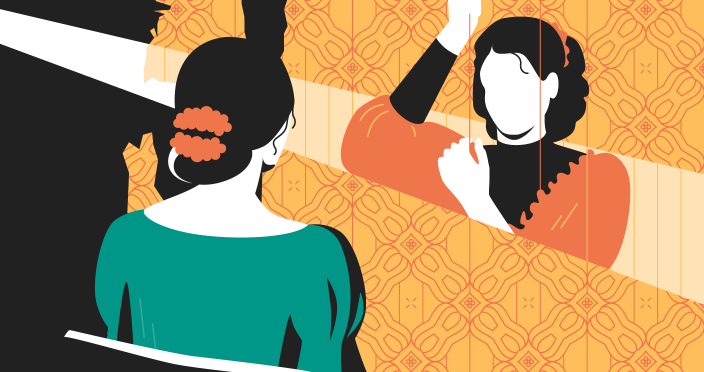There is no one major theme of The Yellow Wallpaper, but a few central ones: feminism and gender roles, freedom of expression, and mental illness.
Welcome to The Yellow Wallpaper themes & symbols page prepared by our editorial team!
🎵 The Yellow Wallpaper Themes
The Yellow Wallpaper tackles several themes relevant in modern times. The central conflict in the short story is the main character’s lack of agency resulting from her being a product of the patriarchal setting. Her inability to express herself is exacerbated even further by the need to conform to societal norms of the time.
Mental Illness in The Yellow Wallpaper

Although the mental illness is never given a name, it’s clear from the context that the main character is suffering from postpartum depression. It was poorly understood at the time, and the most common treatment was the so-called “rest cure,” which didn’t work. Charlotte Perkins Gilman, the author, learned it the hard way and described it in her short story.
But these nervous troubles are dreadfully depressing. John does not know how much I really suffer. He knows there is no reason to suffer, and that satisfies him.
The Yellow Wallpaper, Narrator, Entry 2
The Yellow Wallpaper as an Autobiography
The Yellow Wallpaper is a semi-autobiographical story, as evidenced in Charlotte Perkins Gilman’s Why I Wrote ‘The Yellow Wallpaper. The writer posted this short article to address some of the questions readers had been mailing to her. Specifically, people were amazed by the apparent authenticity of the main character’s experience. Could it be that Gilman managed to grasp the details so masterfully precisely because she had experienced them firsthand?
As Gilman states in the article, she wrote the short story not to shock and appall the public with its gothic horror mental illness extravaganza. Instead, it was planned to be a cautionary tale against the use of “rest cure” for women diagnosed with postpartum depression. She was indeed a survivor of this novelty treatment, the newest invention of the most venerable psychiatrist in the city. After Gilman gave birth to her firstborn, she could not enjoy motherhood. As it was revealed in her autobiography, while holding her baby, she felt nothing but pain.
Upon consulting with Dr. Silas Weir Mitchell, she was diagnosed with “nervous exhaustion,” aka “neurasthenia,” and the freaky escapade was on. Gilman was forcefully bedridden for an entire month with no visitors allowed, being fed fat-rich products to give her body extra sustenance. She was forbidden to get up from bed, read, write, talk, and she couldn’t even feed herself. After four weeks of this torture, she went home and proceeded to follow the “solemn” instructions of the “wise man.”
Live as domestic a life as possible. Have but two hours’ intellectual life a day. And never touch pen, brush, or pencil as long as you live.
According to Gilman, after three months of such life, she “came so near the borderline of “utter ruin” that she “could see over.” Recognizing the danger, she “cast the noted specialist’s advice to the winds and went to work again – work, the normal life of every human being; work, in which is joy and growth and service, without which one is a pauper and a parasite.”
After recovering her strength, Gilman wrote The Yellow Wallpaper adding some colorful details for a more significant expressive effect. She actually “never had hallucinations or objections” to her “mural decorations.” Gilman wrote the story not “to drive people crazy, but to save people from being driven crazy, and it worked.” The public was impressed by the bold descriptions of a descent into madness. There were instances of abandoning the treatment, which the author was notified of to her great joy. It was also said that the “noted specialist” went on to alter “his treatment of neurasthenia since reading The Yellow Wallpaper” – although he “never acknowledged it.”
Gender Roles in The Yellow Wallpaper

The question of gender is all-prevalent in The Yellow Wallpaper. The story is often regarded to commend feminism because the author portrays the relationship between the wife and the husband. Both assume their respective gender roles. The husband is rational, right, authorial, always confident, never uncertain. The wife is timid, shy, and submissive. She looks up to her husband as her senior, questions her judgment, and prioritizes his needs and feelings over hers.
John laughs at me, of course, but one expects that in marriage.
The Yellow Wallpaper, Narrator, Entry 1
This rigid distribution of roles eventually results in a disaster. The feminist discourse doesn’t necessarily imply that having such dynamics in a couple is ultimately wrong. According to feminist critique, what is wrong is to force it upon all people, as expected in a patriarchal society. When the expectations go astray, and the reality kicks in, one might expect a massive failure.
The patriarchal setting doesn’t taint just the interpersonal relationships, though. It’s evident from the story that the very system is contaminated by this way of thinking. It’s not just the personal and professional agency of women that is in jeopardy – the unbiased perception of their words is critical to their very well-being. The patriarchal set of mind clouds the medical judgment of male doctors and disallows medical professionals to evaluate things correctly. The Yellow Wallpaper tackles the “rest cure” question specifically. If the doctors cared to listen to their female patients, it would be evident that this treatment doesn’t work. But if a doctor intends to go the “confident patriarch” way, then the feelings and opinions of his female patients cease to matter.
The treatment you’ve prescribed works because you are always right and because you said so. Take the narrator’s husband, John, for example.
If a physician of high standing, and one’s husband, assures friends and relatives that there is nothing the matter with one but temporary nervous depression – a slight hysterical tendency – what is one to do?
The Yellow Wallpaper, Narrator, Entry 1
John’s being ashamed of his wife’s not society-friendly condition, as well as his unwavering confidence in his judgment, resulted in his complete blindness to the progression of his wife’s sickness. And when it was too late, who was to blame – the husband for being so rigid-thinking, so narrow-minded? The wife for not finding the strength to stand up for herself? Or the patriarchal society that produced those two individuals in the first place?
Freedom of Expression in The Yellow Wallpaper

One of the major themes explored in The Yellow Wallpaper is freedom of expression. The main character of the story is denied it every step of the way. As a woman, she is expected to assume a submissive position and to prioritize the wants of others before hers. Then, her desire for self-expression is regarded as not just unnecessary but actively hazardous.
A woman has no place to do mental labor in the patriarchal setting because her primary function is that of a wife and a mother, a servant to the family, and the husband.
Once she upsets this “natural order,” all sorts of weirdness and disorder is to be expected, hence the ban on mental activities for the narrator.
I think sometimes that if I were only well enough to write a little it would relieve the press of ideas and rest me.
The Yellow Wallpaper, Narrator, Entry 2
The particular tragedy of this situation is that the narrator herself internalizes this way of thinking. She accepts the control of society and her husband over her life and her decisions. The conflict between how things are and she chooses to interpret them is the main reason for the eventual misfortune. Her entire being reacts to the harmful environment she is in. She seeks to express the things she cannot share with anybody through writing a secret diary, which, of course, is not nearly enough. She feels anger towards her husband for not listening to her, for constantly putting her down, for making her suffer because “it’s doing her good.” But the idea that the husband is always right is so deeply ingrained in the narrator that she doesn’t believe her feelings and sweeps them under the carpet.
I suppose John never was nervous in his life. He laughs at me so about this wallpaper!
The Yellow Wallpaper, Narrator, Entry 2
The immense shame of her disability makes matters even worse. The narrator keeps telling herself how her husband loves her and how her feelings are uncalled for. The only way for her psyche to free itself is by breaking. Only when she goes mad can she express her anger with being locked up and her distrust of her captors freely.
🌈 Symbols in The Yellow Wallpaper

The most profound image in the story is that of the yellow wallpaper. It’s the most well-described thing from the narrator’s surroundings, being the source of her unhealthy fixation. She finds an excuse to practice her writing skills, coming up with the most colorful, detailed, and creative ways to describe what has captivated her imagination.
This paper looks to me as if it knew what a vicious influence it had!
The Yellow Wallpaper, Narrator, Entry 2
Nevertheless, the wallpaper is not the source of pleasure for the disturbed mind of the narrator. On the contrary, she hates it. In her mind, the wallpaper symbolizes everything unpleasant there is.
What Does the Yellow Wallpaper Symbolize?
The yellow wallpaper is what the narrator gets unwillingly fixated on to give herself the mental exercise she is deprived of. The yellow color of the wallpaper is disgusting and reminds of all things yellow that are foul. But the absolute horror, according to the narrator, is the pattern – the prison bars of the room where she’s caged.
The faint figure behind seemed to shake the pattern, just as if she wanted to get out. I got up softly and went to feel and see if the paper did move…
The Yellow Wallpaper, Narrator, Entry 5
The Woman behind the wallpaper is trapped by the pattern and shakes it like prison bars, trying to get out.
The narrator is trapped in the room with the thing she hates. Just like her, the Woman behind the wallpaper is trapped behind the pattern. In the end, the narrator tears down the wallpaper, helping the Woman behind the wallpaper, who is at this point herself, to get out.
Thus, she symbolically frees herself from the pressure of societal norms she has been forced to adhere to. Unfortunately, this act is not therapeutic but a final step towards a complete mental breakdown. Only by becoming the Woman behind the wallpaper can the narrator be finally free to do what she pleases.
Imagery in The Yellow Wallpaper
The story’s primary focus is on the wallpaper. Its imagery is vivid: the color, repellant shades of yellow; the pattern, slanting waves of optic horror; a shadow figure, stooping down and crawling. The picture contrasts with the idyllic descriptions of the house and the surroundings. It symbolizes the perceived peacefulness of family life versus the hidden sorrow and suffering of the narrator.
🌎 The Yellow Wallpaper: Setting
The Yellow Wallpaper is set in America of the late 19th century. It presents a realistic depiction of contemporary social relationships of the time. The story is centered in a desolate mansion, as it’s customary for the Gothic genre narrative. The room where the Woman spends most of her time symbolizes the prison of social pressure crushing the narrator.
📍 The Yellow Wallpaper: Point of View
The point of view in The Yellow Wallpaper is first-person. The author chooses to present the story through the narrator’s eyes to give an intimate insight into her world. It’s the best way to make the reader feel for the sick Woman and see the world she lives in through her eyes, casting away judgment.
🖋️ The Yellow Wallpaper: Literary Devices
The author of The Yellow Wallpaper uses several literary devices in the story, such as personification, simile, and dramatic irony. They all serve the purpose of communicating to the reader the impending horror of the narrator’s gradual descent into madness. There are common Gothic elements in the story, such as first-person narration, a lonely house, and suspense.



